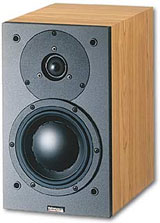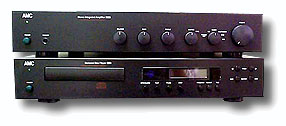![[SoundStage!]](../sslogo3.gif) Standout Systems Standout SystemsBack Issue Article |
| July 2000 High-Value, High-Fun High End While it's easy to find reviews of audio components, there isn't much written about what goes into assembling a satisfying system. One of the main things I've always found driving my own systems is the recognition that upgrades are inevitable, either for performance reasons or because of older equipment wearing out. So whether I'm putting something together for myself or helping a friend decide what to purchase, I try to focus on what makes sense tomorrow as well as today, so that I'm not throwing anything away after an upgrade. With this in mind, the obvious front-end for a system right now is a good DVD player. The nearly unanimous choice among SoundStage! reviewers lately for low-budget DVD is the Pioneer DV-525 ($250- $300 street price), and after purchasing one myself recently I can understand why. The unit is constructed about as well as any player you'll find in the sub-$500 range. It's one of the few players on the market that will track most recordable CD media. This isn't just an issue for music I record myself anymore; lately I've been finding small bands that I like to listen to are starting to make short production runs on CD-R. The DV-525 includes built-in 24/96 DACs, which means you'll be able to play some of the fantastic music in that format released by companies like Classic Records and Chesky. The analog outputs of this player sound far better than those of the Parasound C/DC- 1500 I've been using the last few years, especially in terms of high-frequency detail and imaging. I'm hard-pressed to name any $300 CD player that sounds this good. And unlike most budget players, the digital outputs are capable of outputting 24/96 audio. When you decide you'd like to upgrade this part of the system, you can add an outboard DAC like the MSB Link. Finally, don't forget that since this is a DVD-Video player, it can serve as the source for a home theater in the future as well. The only criticism I've seen of the DV-525 is that its video is a bit on the dark side compared with comparable models from Toshiba, Sony and the like. I happen to think the world at large typically sets their video brightness way too high, so this is never an issue for me; I'm always turning CRTs down, so if the player does a bit of that naturally, it's not a problem.
Finally, the Audience 40 is part of a complete line of Dynaudio speakers with matched tonal characteristics. If you later want to get one of the company's bigger models, you're likely to find those are a straightforward upgrade. Unlike switching speaker manufacturers, upgrades within a family of speakers don't require retuning the rest of your system quite so much. And should you want to build a home-theater system in the future, five Audience 40 speakers plus a subwoofer wouldn't be a bad choice at all, assuming the magnetic shielding on the center speaker was good enough for your placement. Dynaudio also offers the more upscale LS120+ speakers and matching C120+ center-channel.
For connecting the components in modestly priced systems lately, I've settled on two products. The JPS Labs Ultra Conductor interconnect is quite uncolored and transparent, and at a retail price of $109 per meter pair, it's likely to be affordable to someone buying the other pieces I've assembled. A single piece to connect the DVD player to the amplifier makes a big upgrade compared with almost any less expensive choice. If you really want to go whole hog, you can get a second set for connecting the preamp and power amplifier sections of the AMC 3020 to replace the metal jumpers that the factory supplies. I had JPS Labs make me up a very short length of their interconnect just for this purpose, which definitely reduces cable clutter and has the potential to sound a little bit better; when possible, shorter cables should always be preferable. Unfortunately, buying a little jumper doesn't save much money over what a full half-meter sells for, as the expensive parts of the cable construction are the connectors and the termination. If your budget is too tight for the JPS Labs interconnect, I did get decent results connecting the DV-525 and AMC 3020 with either the Belden 89259 cable or using Radio Shack's "Gold Series" interconnects (around $10). Inexpensive speaker cable is a minefield filled with embarrassing products. Fat stranded cables you could start your car with? You can kiss your imaging goodbye. Fancy-budget network boxes that claim to straighten out all your existing problems? Nobody ever asks what different problems you'll get in return. I keep coming back to solid-core cable bundles with a medium gauge overall -- around 16AWG total, with individual conductors smaller than that. AudioQuest Type 4 is a well-constructed cable of this size, with a bundle of two 17AWG and two 20AWG runs. No cable is perfect, especially an inexpensive one, but this one is free of really obvious exaggerations or flaws and therefore has a better balance than most budget speaker cables. If you want to save some money here, I've found that the bulk cable terminated with inexpensive connectors (like the spades sold at Radio Shack) retains the basic goodness of the cable while providing a cost reduction. Audio Advisor sells a version of the cable they terminate this way, and after experimenting, I'd say that choosing to save some money in this fashion is not a bad tradeoff to make in a budget system. Now that all the parts are assembled, how does this system sound? The main thing that strikes me about this combination is its resolving power. Since every component has better-than-average resolution at high frequencies, with the Audience 40 even being a bit emphasized there, the level of detail and ambiance retrieval set new standards for me as far as what was possible for a system under $2000. Even a few years ago it would have been impossible to put together a system sounding this precise while maintaining a good overall balance without spending over twice as much as today's price tag. Also impressive is the breadth and depth of the soundstage rendered by this system. Ultimately this is limited by the electronics involved (a better power amplifier, in particular, helps), but even given this the soundstage width and depth are surprisingly large. When I first started putting together high-end audio systems in the early '90s, it was incredibly challenging to assemble anything based around a digital front-end that wasn't abrasive, no matter how much you spent. Similarly, finding an inexpensive amplifier that managed both solid bass output while actually imaging without spending well over $500 was a challenge. Speaker technology and manufacturing hasn't stood still either, with amazingly compact and modestly priced boxes now available that are very accurate. Don't listen to the doom and gloom coming out of the high-end industry lately; on the consumer side of things, things are going great. Right now is a fabulous time to be assembling a system at any price point; the $1500 spent on this setup buys a whole lot of fun. ...Greg Smith
|
|
![[SoundStage!]](../sslogo3.gif) All Contents All ContentsCopyright © 2000 SoundStage! All Rights Reserved |
 There are a lot of
inexpensive speakers you can build a system around. One pair that I became fond of
recently are the Dynaudio Audience 40s ($699). Several characteristics
make these ideal for putting together a rig serving both current and future needs. First,
the quality of the speakers is high enough that they can match a wide range of amplifiers.
As long as you've got something capable of competently driving a 4-ohm load, the amplifier
is likely to sound decent driving this speaker. Meanwhile, the speaker is by no means
embarrassed should your spending on power head into four digits. Second, the speakers are
small and flexible enough in placement that they'll work well even in a compact room. The
availability of port plugs to correct the response if the speaker needs to be close to a
wall is an added bonus here. Note that you'll need to match the Audience 40 with an
appropriate stand; my recent
There are a lot of
inexpensive speakers you can build a system around. One pair that I became fond of
recently are the Dynaudio Audience 40s ($699). Several characteristics
make these ideal for putting together a rig serving both current and future needs. First,
the quality of the speakers is high enough that they can match a wide range of amplifiers.
As long as you've got something capable of competently driving a 4-ohm load, the amplifier
is likely to sound decent driving this speaker. Meanwhile, the speaker is by no means
embarrassed should your spending on power head into four digits. Second, the speakers are
small and flexible enough in placement that they'll work well even in a compact room. The
availability of port plugs to correct the response if the speaker needs to be close to a
wall is an added bonus here. Note that you'll need to match the Audience 40 with an
appropriate stand; my recent  Having tested it with nearly a dozen different speakers
and half a dozen CD/DVD players, I have yet to hear the AMC 3020
integrated amplifier ($279) sound bad. With its increasing power into 4-ohm speakers, it's
certainly an excellent starter amplifier for use with the Audience 40s, with one caveat
being that your volume is going to be a bit limited because of the relatively low power
output. What I really like about recommending the 3020 at the center of a system is that
it's very flexible when the upgrade bug starts to bite you. Separate preamp and power-amp
sections, both well engineered on their own, mean you can upgrade either section alone and
continue to use half the AMC unit. Plus, if you've gotten to where you've totally phased
out needing the 3020, its mixing capability (aimed primarily at computer usage) makes it
well suited for a variety of special projects. Even if it's been replaced with better
components in your main system, it's always possible to find a second system this
integrated amp would be an excellent choice for.
Having tested it with nearly a dozen different speakers
and half a dozen CD/DVD players, I have yet to hear the AMC 3020
integrated amplifier ($279) sound bad. With its increasing power into 4-ohm speakers, it's
certainly an excellent starter amplifier for use with the Audience 40s, with one caveat
being that your volume is going to be a bit limited because of the relatively low power
output. What I really like about recommending the 3020 at the center of a system is that
it's very flexible when the upgrade bug starts to bite you. Separate preamp and power-amp
sections, both well engineered on their own, mean you can upgrade either section alone and
continue to use half the AMC unit. Plus, if you've gotten to where you've totally phased
out needing the 3020, its mixing capability (aimed primarily at computer usage) makes it
well suited for a variety of special projects. Even if it's been replaced with better
components in your main system, it's always possible to find a second system this
integrated amp would be an excellent choice for.